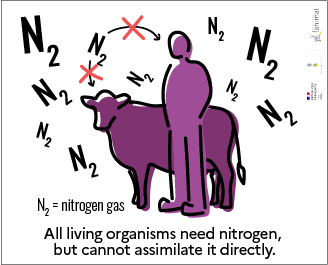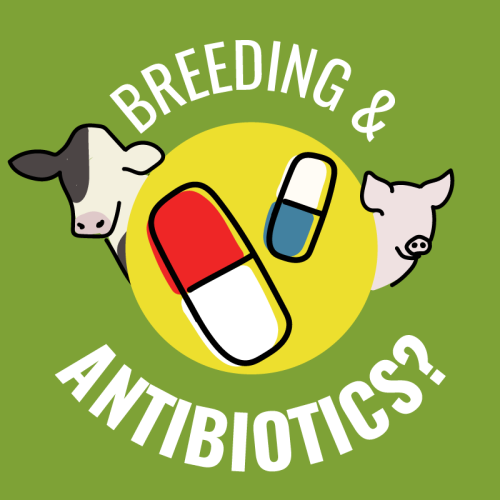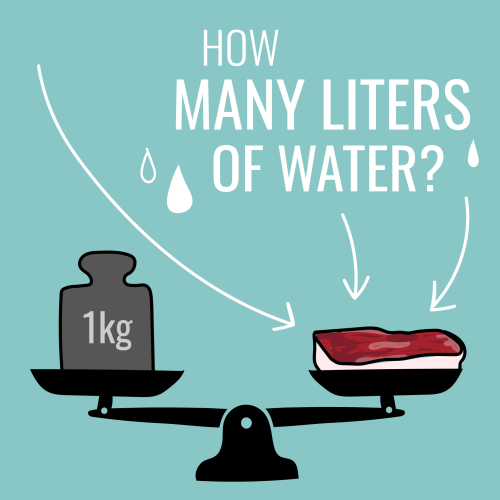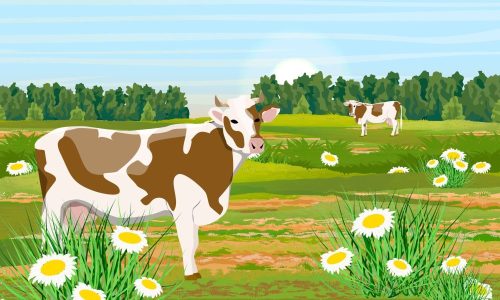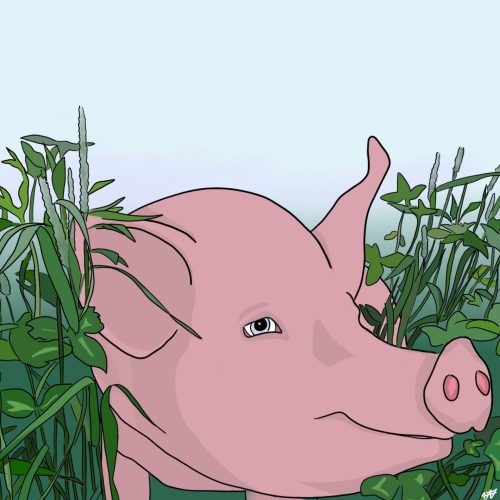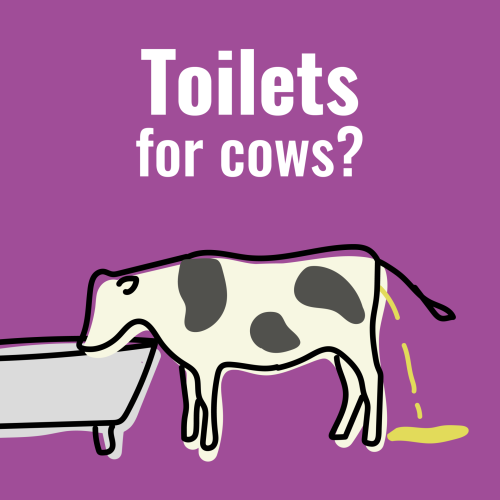
The CowToilet, manufactured and marketed by Dutch company Hanskamp, has been a subject of research by the Wageningen University (Netherlands) to demonstrate its impact on reducing ammonia emissions from dairy cows. Published in December 2023, the results are encouraging!

Keep in mind
- For livestock in buildings, effluent storage creates problems of ammonia volatilization and loss.
- Ammonia emissions from dairy barns come mainly from the urea contained in the urine excreted by cows.
- The CowToilet system collects part of the urine before it reaches the ground, reducing ammonia emissions by 35% to 47% compared with traditional dairy farming systems.
The CowToilet, manufactured and marketed by Dutch company Hanskamp, has been a subject of research by the Wageningen University (Netherlands) to demonstrate its impact on reducing ammonia emissions from dairy cows. Published in December 2023, the results are encouraging!
Why reduce ammonia emissions?
All living beings need nitrogen, but the N2 form, a major constituent of the atmosphere, can only be assimilated by certain microorganisms. Nitrogen evolves in a natural cycle of transformation within ecosystems.

Did you know?
Our atmosphere is 78% nitrogen gas (N2).
Plants can absorb nitrogen in the form of nitrate (NO3–) and, to a lesser extent, in the form of ammonium (NH4+) and amino acids. Humans and animals absorb the nitrogen they need by eating these plants, and then excrete it mainly as urea in urine and, to a lesser extent, in feces. Urea is transformed by enzymes, bacteria and fungi in the soil, into ammonium (NH4+) and then nitrate (NO3–). It can also volatilize as ammonia (NH3) in contact with air.
Nitrogen is a natural compound essential to most living beings for protein synthesis. Necessary for photosynthesis, it is used in agriculture in the form of mineral fertilizers made from nitrogen in the air and natural gases[1]. Urine can also be used in its natural form as a fertilizer, since it is rich in nitrogen and potassium – two elements that are highly beneficial to plant development. Its high water content facilitates infiltration into the soil and absorption by plants.
However, excess nitrogen in the environment has an adverse effect on human and animal health. In the air, for example, excess ammonia produces irritating, even toxic effects (on eyes, skin and lungs). Present in excess in soils, it can become a major pollutant when carried in soluble form in water leaching soils (soil acidification, eutrophication of watercourses, loss of biodiversity, etc.).
Cattle farming produces ammonia
Livestock farming in general, and dairy farming in particular, is a major source of ammonia emissions that must be limited to reduce environmental pollution and its consequences on human and animal health. Following the 2016 European NEC-2 (National Emission Ceilings) Directive, ammonia reduction targets have been set for member states, by 2030 (-13% for France). Within this framework, the Netherlands has set maximum quotas to limit ammonia emissions per animal per year, depending on the animal housing system. The Dutch ambition is to design stables that reduce ammonia emissions, taking into account animal welfare issues.

Did you know?
In France, 94% of ammonia emissions come from agriculture, including 68% from cattle farms. In this sector, 23% of ammonia emissions are linked to the management of animal manure (2021 figures - Secten 2023 Citepa report).
In the case of livestock buildings, effluent storage creates problems of ammonia volatilization and nitrogen loss. Ammonia emissions from dairy barns are mainly due to the urea contained in the urine excreted by cows. This urea is naturally:
- Converted to ammonia (NH3), which volatilizes in gaseous form in the first few hours after excretion,
- Diffused by puddles of urine on the ground or by the top layer of liquid manure (a mixture of urine and feces) in the form of ammonium (NH4+ ) and nitrate (NO3–). This phenomenon is exacerbated when effluent is stored in the open air (and then spread).
Over the past few decades, the development of alternatives to reduce ammonia emissions from animal excrement has focused in part on draining or removing urine from the floor of buildings.
A simple principle: separate urine from feces
The CowToilet system collects part of the urine before it reaches the ground. In this way, the main source of ammonia emissions (urine) is removed from the building and stored in a closed tank where it produces negligible emissions.
The study carried out by the Wageningen University shows that using the Cowtoilet reduces ammonia emissions by 35% to 47% compared with traditional dairy farming on concrete slatted floors. While these measurements need to be confirmed by further experiments on other dairy farms before the system can be officially recognized in the Netherlands as a low-emission system, these initial results already look promising.

Did you know?
Other levers of action exist to limit ammonia emissions on dairy farms: reducing the nitrogen concentration of feed distributed through quality forage, increasing the frequency of floor cleaning in buildings, putting a lid on slurry pits, increasing the duration of animal grazing, modifying manure spreading practices to limit direct contact with air, etc.
(For more information, see the fact sheet " Levers for reducing ammonia emissions on cattle farms " - Idele, Cniel, Interbev).
How does it work?
Cowtoilet devices are positioned at the feeding stations (automatic concentrate dispensers) of dairy cows. While a cow is feeding, a mechanical arm automatically lowers and touches the nerve endings of the cow’s perineum, inducing urination. In this way, 35% of the urine is collected in a small tank and then discharged into a larger, closed storage tank to prevent volatilization of the gaseous ammonia. In addition, a permeable plate positioned on the slatted floor collects the remaining urine underneath, improving hoof hygiene and limb conformation, thus improving welfare. With this system, building cleaning costs are reduced. Another advantage: the urine collected can be used as a raw material for fertilizing cover crops, just like a mineral fertilizer.
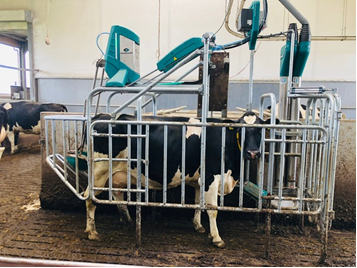
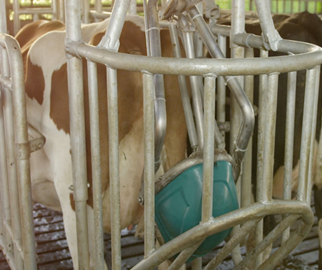
The Cowtoilet has been tested in the Netherlands since 2021, as well as in Germany. The concept is also being tested on milking robots. Other urine-feces separation systems are also being studied for other types of dairy cow housing. This is particularly the case in buildings with free cow traffic, where sand bedding and drains are put in place, allowing urine to be collected. As for dry toilets for cows, they’ve been around for a long time: it’s manure (feces + straw)!
For further information
If you’d like to find out more, read the study by the Wageningen University (Netherlands).
Article reviewed by Paul Villate, Lecturer in Animal and Plant Sciences at VetAgroSup and Nathalie Vassal, Senior Lecturer in Grassland Systems at VetAgroSup.
Keep in mind
- For livestock in buildings, effluent storage creates problems of ammonia volatilization and loss.
- Ammonia emissions from dairy barns come mainly from the urea contained in the urine excreted by cows.
- The CowToilet system collects part of the urine before it reaches the ground, reducing ammonia emissions by 35% to 47% compared with traditional dairy farming systems.
Key Figure
Ammonia emission reduction targets for France by 2030

